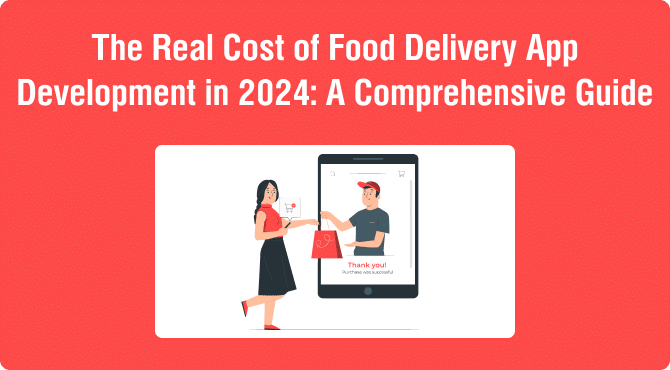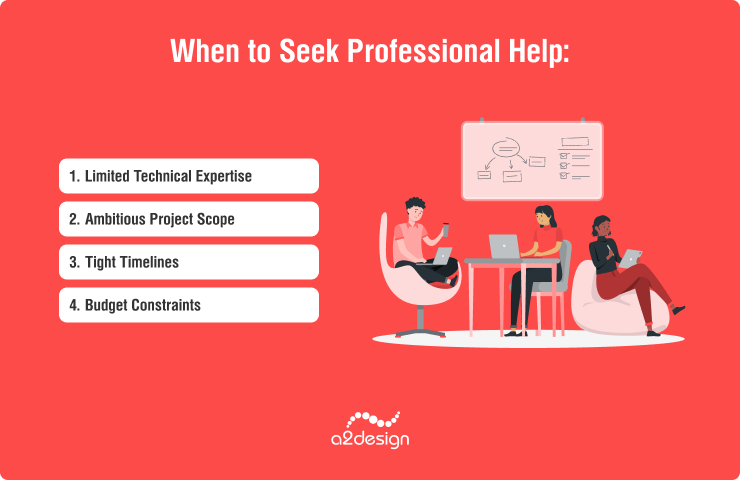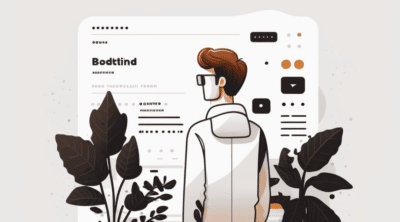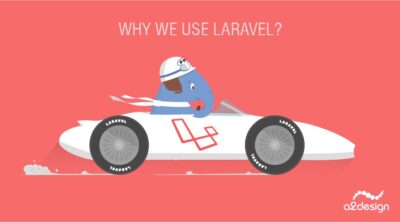The Real Cost of Food Delivery App Development in 2024: A Comprehensive Guide


The global demand for food delivery isn’t just increasing; it’s skyrocketing. The revenue in the Online Food Delivery market is forecasted to reach US.22tn in 2024, and is expected to exhibit a compound annual growth rate (CAGR 2024-2029) of 9.49%. With the booming and growing market, the success of industry leaders like Uber Eats and DoorDash is enticing both entrepreneurs and established businesses to carve their niche in this profitable sector. But how does one create a food delivery app that can compete with the giants?
Fundamentally, a food delivery app bridges the gap between eager customers and a diverse range of restaurants, offering a seamless experience for browsing, ordering, and receiving food at their preferred location. While this concept appears straightforward, it relies on an intricate network of functionalities, from user-friendly menus and secure payment gateways to real-time order tracking and customer review systems.
Developing a food delivery app that resonates with users and sets itself apart requires thoughtful consideration of numerous elements, each influencing the final investment. These range from the app’s features and overall design to the chosen technology stack and the expertise of the development team.
Read Related
In this in-depth guide, we will delve into the intricacies of food delivery app development, exposing the various components that contribute to its overall cost. Here’s what this exploration will cover:
- A detailed examination of essential and additional features that impact both user experience and budget.
- Insights into the technology decisions that can significantly affect your app’s performance and ability to grow.
- A breakdown of the financial implications associated with design, development, and ongoing maintenance.
- Guidance on establishing a practical budget and pinpointing potential revenue avenues.
- An introduction to A2 Design, a reputable partner specializing in the creation of successful and cost-effective food delivery apps.
By gaining a deeper understanding of the nuances of app development costs, you’ll be equipped to make well-informed choices that align with your vision and financial capabilities. Join us as we navigate the complexities and unlock the true potential of your food delivery app
Core Factors Influencing Food Delivery App Development CostWhen building a house, the materials you choose greatly impact the final price. Similarly, the components of your food delivery app significantly influence its development cost. These components, or factors, are interconnected, and understanding them is key to planning a budget that aligns with your vision and goals. Let’s explore the core elements that shape the investment required for crafting your app.

App Complexity and Features
The range of features you choose for your food delivery app can be likened to a menu at a restaurant – from a simple, satisfying meal to a multi-course feast. Each option comes with varying costs and levels of complexity. Understanding these tiers is essential in balancing your desired user experience with your budget.
Minimum Viable Product (MVP):
This is the most basic version of your app, including only the essential features needed for launch. An MVP typically includes:
- Menu browsing and search
- Order placement and customization
- Secure payment integration
- Basic order tracking
- User profiles for account management
Read Related
Full-Featured App:
This is a more comprehensive platform, packed with features to enhance the user experience and set your app apart. In addition to the MVP features, it may include:
- Advanced search and filtering (by cuisine, dietary restrictions, etc.)
- Personalized recommendations and promotions
- Loyalty programs and rewards
- Scheduled ordering and group ordering options
- Real-time driver tracking with estimated arrival times
- In-app customer support (live chat or messaging)
- Social sharing and referral programs
Each additional feature, while enhancing the user experience, naturally increases the complexity and cost of development. This is due to the additional time and resources required for design, coding, testing, and integration.
Furthermore, customization plays a significant role. Developing unique features or highly tailored designs can substantially elevate the cost. These may include:
- Custom animations or interactive elements
- Proprietary algorithms for recommendations or search
- Integration with third-party services (e.g., loyalty programs, delivery management)
Therefore, it’s crucial to carefully consider your target audience and prioritize the features that will provide the most value while remaining within your budgetary constraints.
Technology Stack
The technological foundation upon which your food delivery app is built carries considerable weight. This “tech stack” is analogous to the architecture of a building: it determines stability, functionality, and the resources required for construction. Let’s analyze the primary options and their financial implications:
Native development
With native development, you’re essentially building distinct, tailor-made applications for each operating system you intend to cater to. This entails crafting one app exclusively for iOS, employing languages such as Swift or Objective-C, and a separate app for Android, utilizing languages like Java or Kotlin.
Pros:
- Optimal performance and responsiveness, as each app is meticulously crafted to fully harness the distinct capabilities and functionalities inherent to its respective platform.
- Smooth user experience, adhering to platform-specific design guidelines.
- Native apps have the advantage of seamlessly integrating with a device’s full range of capabilities, such as the camera for scanning QR codes, GPS for precise location services, and push notifications for timely updates and alerts.
Cons:
- Increased development expenses arise from the need to manage distinct codebases for both iOS and Android platforms.
- The development process may take longer due to the creation of multiple tailored applications.
Hybrid development
This approach takes a different route, utilizing familiar web technologies (HTML, CSS, and JavaScript) as the foundation, then packaging them within a native container. This approach enables the app to function across multiple platforms using a single, shared codebase.
Pros:
- Lower costs and faster development time than native development.
Cons:
- Certain limitations in performance might arise, particularly for apps that demand substantial graphical processing.
- Access to some device-specific functionalities might be restricted compared to native apps.
Cross-platform development
This offers a distinct pathway, utilizing frameworks like React Native or Flutter. This methodology allows for the construction of applications that function seamlessly across diverse platforms, all while stemming from a unified source of code.
Pros:
- Lower costs and faster development time than native development.
- Generally good performance, though not always matching native levels.
Cons:
- May face limitations in accessing specific device features or achieving peak performance compared to native apps.
Selecting the most suitable technology hinges on your specific needs and budget. A2 Design excels in providing expert guidance on this critical decision.
We thoroughly assess your goals, target audience, and financial considerations to recommend the technology stack that will deliver the best possible experience for your users while optimizing development resources.
Design and User Experience (UX)
In the digital realm of food delivery, the design and user experience (UX) of your app serve as the virtual storefront and dining room. Just as a well-designed restaurant ambiance attracts and retains customers, an intuitive and visually appealing app interface is pivotal in engaging and keeping users coming back for more.
The Importance of User-Centric Design:
- Intuitive Navigation: Users should be able to effortlessly browse menus, place orders, and manage their accounts without confusion or frustration. A streamlined, logical flow enhances the overall experience.
- Visual Appeal: A visually pleasing app with a cohesive design aesthetic leaves a positive impression. High-quality images of food, clear typography, and a harmonious color palette contribute to an enjoyable browsing experience.
- Responsiveness: The app should load quickly and respond promptly to user interactions. Sluggishness or delays can lead to user abandonment.
- Personalization: Tailoring the experience to individual preferences, such as suggesting restaurants based on past orders or dietary restrictions, fosters a sense of connection and loyalty.
Visual and Interactive Enhancements:
- Bespoke Visuals: Distinctive illustrations can breathe life into your app, imbuing it with a unique character and leaving a lasting impression on users.
- Dynamic Elements: Subtle animations inject a touch of energy and engagement, enhancing the overall user experience.
- Consistent Branding: Integrating your brand’s visual identity (logo, color palette, typography) throughout the app fosters a cohesive and recognizable brand image.
A2 Design’s User-Centric Approach:
At A2 Design, we understand that user-centric design isn’t just about aesthetics; it’s a core business strategy. Our approach centers on the following principles:
- Understanding the User: We delve deep into understanding your target audience’s needs, preferences, and challenges through comprehensive research.
- Refining Through Feedback: We believe in continuous improvement. Our design process involves multiple iterations, incorporating valuable user feedback at each stage.
- Real-World Validation: We rigorously test the app with real users to uncover any potential usability issues and ensure a smooth, enjoyable experience.
This unwavering focus on user-centricity empowers A2 Design to create food delivery apps that are not only visually appealing but also intuitive and user-friendly, leading to higher user engagement and loyalty.
Development Team: In-House Team vs. Outsourcing vs. Freelancers
In app development, the team you choose (or assemble) directly impacts the development time, quality, and, ultimately, cost.
There are three main approaches available:
In-house Team: Hiring full-time developers, designers, and project managers as employees.
- Pros: Greater control over the project, direct communication, potential for long-term collaboration.
- Cons: High overhead costs (salaries, benefits, office space), time-consuming recruitment process.
Outsourcing: Partnering with a development agency to handle the entire project or specific tasks.
- Pros: Access to a wider pool of talent, specialized expertise, established project management processes, potentially lower costs than an in-house team.
- Cons: Less direct control, communication challenges across time zones or cultures, potential for hidden costs.
Freelancers: Hiring individual professionals on a contract basis to fulfill specific roles.
- Pros: Cost-effective for smaller projects, flexibility in choosing specific skills, no long-term commitment.
- Cons: Less reliable than in-house or agency teams, potential for varying quality, project management challenges.
Choosing the best approach depends on your budget, project scope, and desired level of control. For complex projects like food delivery apps, partnering with an experienced agency often proves advantageous.
What sets A2 Design apart:
At A2 Design, our team consists of experienced professionals with proven track records for delivering high-quality, user-friendly applications. We cultivate a collaborative environment that emphasizes clear communication and efficient project management. This approach ensures the final product aligns with your specific goals.
Our commitment to excellence and adaptability to your budget makes A2 Design a reliable partner for your app development needs.
Location of the Development Team
The geographic location of your development team can significantly sway your project’s budget. Just as real estate prices fluctuate based on location, so too do the rates of software developers and designers. This variance stems from differences in living costs, average salaries, and the overall demand for tech talent in different regions.
Local Developers: Hiring developers from your own country can be more expensive but offers the advantage of easy communication and coordination.
Offshore Developers: Opting for developers from countries with lower labor costs can reduce expenses, though it may require more effort in communication and managing time zone differences.
Here’s a glimpse of how development costs can vary across regions:
- North America: Typically commands the highest rates due to the mature tech industry and high living standards.
- Western Europe: Similar to North America, development costs are generally higher due to established tech hubs and competitive salaries.
- Eastern Europe: Offers a balance of quality and affordability, with skilled developers at more competitive rates than Western Europe or North America.
- Asia: Certain regions in Asia, such as India and Vietnam, provide cost-effective development options, but thorough vetting of teams is crucial to ensure quality.
A2 Design’s Advantage:
At A2 Design, we are strategically positioned to offer competitive pricing while upholding stringent quality standards. Our team comprises talented professionals from diverse regions, allowing us to optimize costs without compromising on expertise or experience. We leverage this advantage to deliver exceptional value to our clients, ensuring their food delivery app projects are successful without straining their budgets.
Beyond the Core: Hidden Expenses in App DevelopmentWhile the core components we’ve discussed form the backbone of your app’s development cost, they don’t tell the whole story. Several additional factors can significantly influence your final budget. It’s essential to be aware of these potential expenses to avoid unpleasant surprises down the line and ensure a smoother development journey.

Backend and Infrastructure Costs
Think of your food delivery app as a theater production. The frontend, with its captivating design and features, is the dazzling performance on stage. However, the backend is the intricate network of backstage operations – lights, sound, stagehands – that make the show possible. Similarly, the backend of your app, along with its supporting infrastructure, is crucial for smooth operation and scalability.
The backend encompasses the server-side logic, database management, and application programming interfaces (APIs) that handle data processing, user authentication, order management, and communication with third-party services. It’s the engine room that powers your app’s functionality.
Here’s a breakdown of the costs associated with backend development and infrastructure:
- Server Costs: These can vary depending on the number of users, traffic volume, and the complexity of your app’s features. You’ll need to choose a hosting provider and select a suitable server configuration (e.g., shared hosting, virtual private server, dedicated server) to meet your needs.
- Database Management: Storing and managing vast amounts of data (user information, menus, orders, etc.) requires a robust database system. Costs may involve licensing fees for database software, as well as ongoing maintenance and optimization.
- API Development and Integration: If your app interacts with external services like payment gateways, mapping providers, or delivery management systems, you’ll need to develop or integrate APIs. This can add to the development cost, especially if custom integrations are required.
Scalability: Planning for the Future:
One of the most critical aspects of backend infrastructure is scalability. As your app gains popularity and its user base grows, your backend needs to be able to handle the increased traffic and data volume without compromising performance. This might involve upgrading servers, optimizing databases, or implementing load-balancing solutions.
Investing in a scalable backend from the outset can save you from costly reworks or performance issues down the line. A well-architected backend ensures your app can grow seamlessly with your business, providing a consistently smooth experience for your users.
Marketing and App Store Optimization Costs
Imagine crafting a magnificent ship but keeping it hidden in a secluded harbor. Without proper exposure, even the most exceptional vessel remains unnoticed. Similarly, a well-developed food delivery app requires effective marketing and app store optimization (ASO) to gain visibility and attract users in the vast digital ocean.
The Marketing Push:
- Pre-launch Buzz: Generate excitement before your app even hits the market through social media campaigns, teaser videos, and influencer collaborations.
- App Store Launch: A well-planned launch strategy, including press releases and media coverage, can create initial momentum and attract early adopters.
- Ongoing Promotion: Utilize a mix of digital marketing channels – social media advertising, search engine marketing (SEM), content marketing, and email campaigns – to maintain visibility and attract new users.
- Referral Programs: Encourage existing users to spread the word by offering incentives for referring friends and family.
Ready to Create Your Food Delivery App?
Contact UsApp Store Optimization (ASO):
ASO is the process of optimizing your app’s listing in app stores (like Apple’s App Store and Google Play) to improve its visibility in search results and encourage downloads. Key elements of ASO include:
App Title and Keywords: Choose a catchy title that includes relevant keywords users might search for.
App Description: Craft a compelling description that highlights the app’s unique features and benefits.
App Icon and Screenshots: Visually appealing graphics are crucial for attracting attention and conveying the app’s functionality.
Ratings and Reviews: Encourage users to rate and review your app, as positive reviews can boost visibility and credibility.
Marketing and ASO are ongoing efforts. It’s essential to monitor your app’s performance, track user feedback, and adapt your strategies to maximize visibility and user acquisition. By investing in these efforts, you increase the chances of your food delivery app becoming a success story.
Ongoing Maintenance and Updates
Launching your food delivery app is not the finish line; it’s merely the starting point of a continuous journey. Like any software product, your app will require ongoing care and attention to remain functional, secure, and competitive. This ongoing upkeep is a crucial aspect of your budget and planning.
What to expect:
Addressing Imperfections: Despite rigorous testing, some bus and glitches might only become apparent once the app is in users’ hands. Swiftly resolving these problems is paramount to ensure user satisfaction and maintain a stable app environment.
Optimizing Performance: As your app’s user base grows and technology advances, fine-tuning may be necessary to uphold seamless performance and swift loading times.
Enhancing Functionality: Regularly introducing fresh features or refining existing ones helps keep your app engaging and current, aligning with changing user needs and market trends.
Maintaining Compatibility: Operating systems and devices undergo continuous updates. Guaranteeing your app remains compatible with the latest versions is vital to prevent operational hiccups and user dissatisfaction.
Safeguarding Data: Shielding user information and fortifying your app against security weaknesses necessitates routine security updates to counter potential hazards.
Budgeting for Maintenance:
It’s wise to allocate a portion of your budget (typically 15-20% of the initial development cost) for ongoing maintenance. This ensures you have the resources to address issues promptly, adapt to changing technologies, and continue delivering a high-quality user experience.
Partnering for Success:
A reliable development partner like A2 Design can help you navigate the complexities of ongoing maintenance. We offer comprehensive support packages that cover bug fixes, updates, performance optimization, and feature enhancements, allowing you to focus on growing your business while we keep your app running smoothly.
Legal and Licensing Fees
Launching a food delivery app isn’t just about technology and design; it also involves navigating a complex web of legal and licensing requirements. These regulations are designed to protect consumer rights, ensure data privacy, and maintain fair business practices. Overlooking or underestimating these costs can lead to legal complications and financial setbacks.
Critical Legal Considerations:
- Data Protection: Given that food delivery apps gather personal user information, such as names, addresses, payment information, and order history, adherence to applicable data protection regulations is paramount. Regulations like the GDPR in Europe and the CCPA in California mandate strict measures to safeguard this data, with non-compliance potentially leading to substantial penalties.
- Protecting Your Creations: Safeguard your app’s name, logo, and distinctive features by registering trademarks and copyrights to prevent unauthorized use.
- Formalizing Partnerships: Establish clear and comprehensive agreements with restaurants, delivery personnel, and other involved parties to define roles, responsibilities, and potential liabilities.
- Secure Payments: Integrating a robust and compliant payment system is non-negotiable for handling customer transactions. Adherence to established industry benchmarks, such as the Payment Card Industry Data Security Standard (PCI DSS), is paramount to safeguard sensitive cardholder information.
- Food Handling and Delivery: Based on your operational region, obtaining specific licenses or permits might be mandatory for activities involving food preparation, transportation, and overall safety standards.
- Protecting Consumers: It is crucial to ensure that your app’s terms of use, policies regarding refunds, and procedures for resolving disagreements are in accordance with local regulations designed to protect consumers.
Budgeting for Legal Compliance:
The financial outlay for legal compliance can differ significantly based on several factors, including your geographic location, the intricacies of your app, and the specific regulations you must adhere to. Engaging legal experts specializing in technology and data protection is highly recommended to ensure comprehensive compliance.
However, you should generally plan for the following expenditures:
- Fees for legal consultations and advice
- Costs associated with obtaining necessary licenses and permits
- Expenses related to implementing robust data protection measures
- Potential financial penalties for failing to comply with regulations
By proactively addressing these legal and licensing requirements, you not only mitigate potential risks but also cultivate trust with your users, ultimately establishing a solid and secure foundation for your food delivery app venture.
Mapping Your Financial Route: Crafting a Realistic BudgetHaving explored the various factors that influence the cost of developing a food delivery app, it’s time to translate this knowledge into a tangible budget. Think of this as charting a course for your ship – a well-defined budget acts as a compass, guiding your decisions and ensuring you reach your destination without running aground.

Building a Solid Financial Framework:
Estimating the cost of your food delivery app requires a thoughtful approach, taking into account all the factors we’ve explored. Here are some tips to guide you:
- Start with the Core: Begin by outlining the essential features (your MVP) and researching their average development costs. This will provide a baseline estimate.
- Factor in the Variables: Consider the impact of your chosen technology stack, design complexity, team composition, and geographic location on the overall cost.
- Consult with Experts: If unsure, seek guidance from experienced developers or agencies like A2 Design. They can provide detailed estimates based on your specific requirements.
- Plan for the Unexpected: It’s wise to set aside a contingency fund (around 10-20% of your budget) for unforeseen expenses or changes in scope. This ensures you’re prepared for any bumps in the road.
Remember, a well-crafted budget is not set in stone. It should be a dynamic tool that evolves alongside your project. Regularly reviewing and adjusting your budget as needed ensures you stay on track and avoid financial surprises.
Identifying Potential Revenue Streams
While developing a food delivery app requires a significant investment, the potential for generating revenue is substantial. There are several avenues to explore, each with its own advantages and considerations:
- Commission-Based Model: This is the most common approach, where you charge restaurants a percentage of each order placed through your app. This model aligns your interests with the restaurants’, as your revenue grows with their sales.
- Delivery Charges: Charging a fee for delivery services offers a direct way to generate income. This can be structured as a fixed amount or adjusted based on factors like distance traveled or the total value of the order.
- Promotional Opportunities: As your app gains popularity, you can provide advertising space to restaurants or other businesses interested in reaching your user demographic. This could take the form of banner advertisements, sponsored listings, or highlighted promotions within the app.
- Enhanced Services for Businesses: Explore the possibility of offering premium features to restaurants for an additional fee. These could include preferential placement in search results, access to detailed data analytics, or specialized marketing tools.
The most effective approach to monetization will hinge on your specific target market, the competitive landscape, and the broader structure of your business model. Achieving a harmonious equilibrium between revenue generation and delivering value to both restaurants and customers is key to long-term success.
When to Seek Professional Help
While embarking on a food delivery app venture can be exciting, it’s crucial to recognize when seeking professional guidance is beneficial. Complex projects like these often involve numerous moving parts and unforeseen challenges. Here are some scenarios where seeking professional assistance can be invaluable:
- Limited Technical Expertise: If you lack in-house technical knowledge or experience in app development, partnering with professionals can save you time, money, and frustration in the long run.
- Ambitious Project Scope: For large-scale or feature-rich apps, a professional team can bring the necessary expertise and resources to manage the project effectively.
- Tight Timelines: If you have a strict deadline, professionals can help streamline the development process and ensure timely delivery.
- Budget Constraints: Experienced developers can help you optimize your budget by suggesting cost-effective solutions and avoiding unnecessary expenses.
Our Expertise in Building Food Delivery Apps
With a portfolio brimming with successful food delivery app projects, A2 Design has honed its skills in crafting digital experiences that tantalize users’ taste buds and streamline their culinary journeys. Our seasoned developers and designers understand the unique nuances of this industry, ensuring that every app we create is both functional and visually captivating.
Case Study: City Lunch Club – Lunch Subscription Service
One of the food delivery apps that A2 Design has built is the City Lunch Club. It is a subscription-based food delivery platform. It is a technically complex web application that incorporates different user groups, recurring payments, and intelligent clustering of customers per restaurant based on address.
A Recipe for Cost-Effective Excellence:
At A2 Design, we believe in transparent and collaborative partnerships. Our pricing models are clear and upfront, with no hidden fees or surprises. We focus on delivering tangible value at every stage of development, ensuring your investment translates into a high-quality app that resonates with your target audience.
Our Core Ingredients for Success:
- Uncompromising Quality: We adhere to rigorous quality standards, employing industry best practices and cutting-edge technologies to create apps that perform flawlessly.
- User-Centric Design: We prioritize user needs and preferences, crafting intuitive interfaces that are easy to navigate and visually pleasing.
- Timely Delivery: We understand the importance of launching your app on schedule. Our streamlined project management processes ensure efficient development and timely delivery.
Ready to Cook Up Your App?
If you’re ready to embark on your food delivery app journey, A2 Design is here to guide you every step of the way. We invite you to schedule a complimentary consultation with our team to discuss your vision, explore possibilities, and receive personalized guidance on crafting an app that leaves a lasting impression.
Your culinary app dream is within reach. Let A2 Design help you turn it into a delectable reality.
Wrapping UpThe financial landscape of food delivery app development is intricate, shaped by a myriad of factors from features and technology to design and legal considerations. Thorough planning and meticulous budgeting are paramount for navigating this terrain successfully. Armed with a comprehensive understanding of these costs, you can make informed choices that align with your unique vision and financial capabilities. Remember, your app is an investment, and by carefully considering your options, you can maximize its potential for success.





